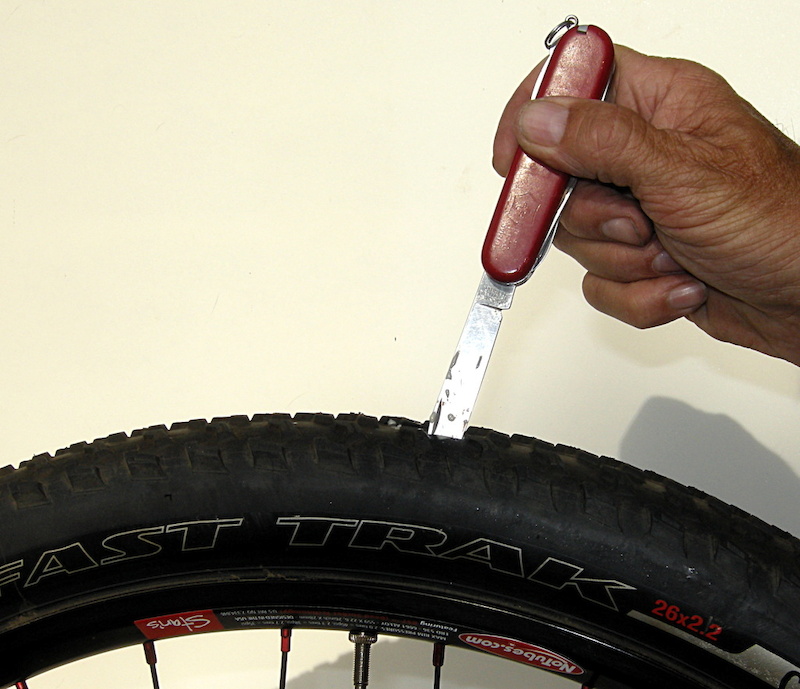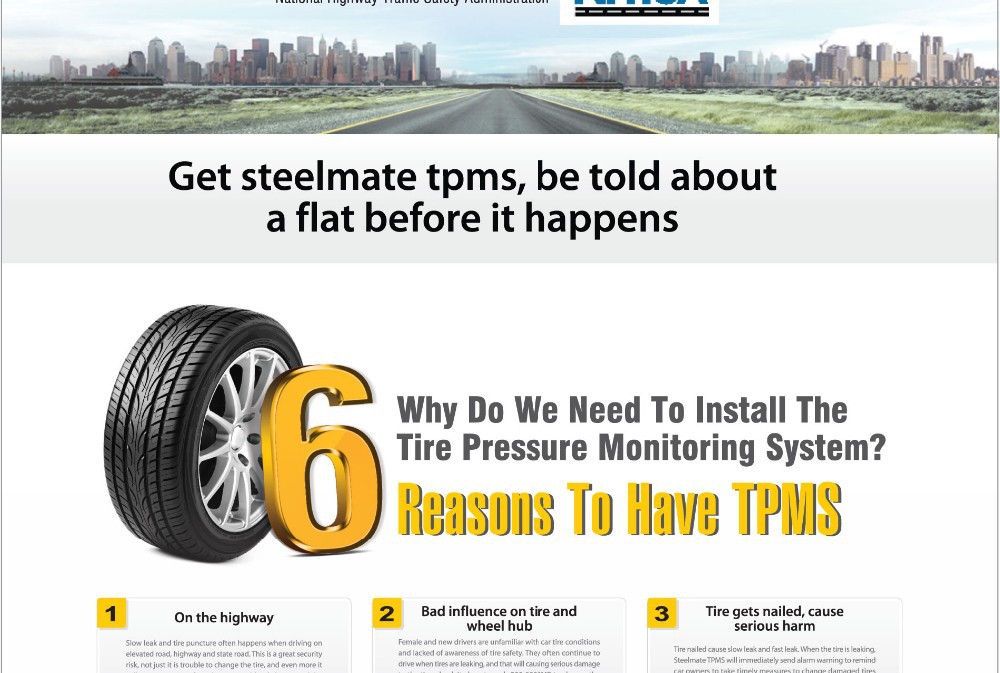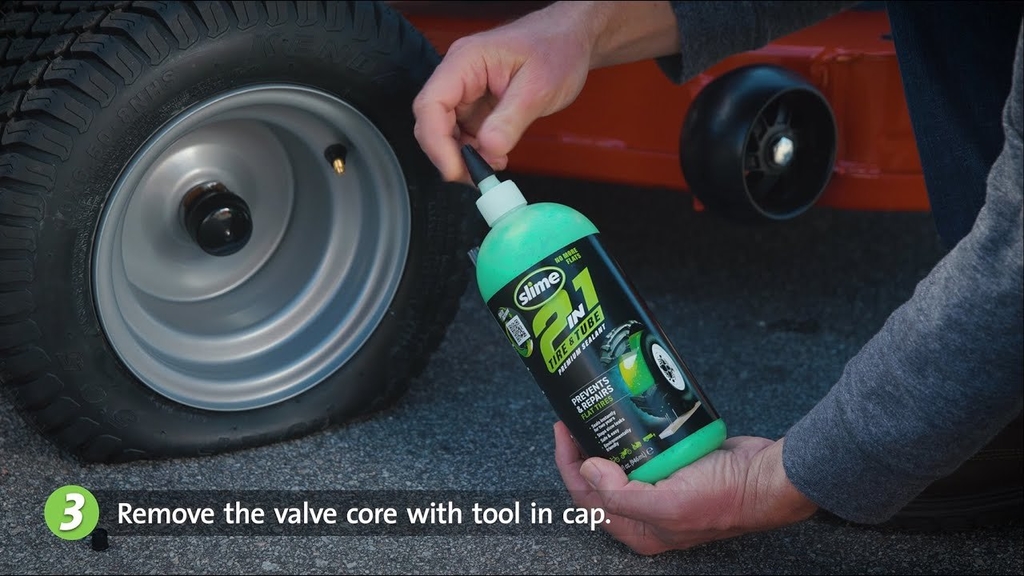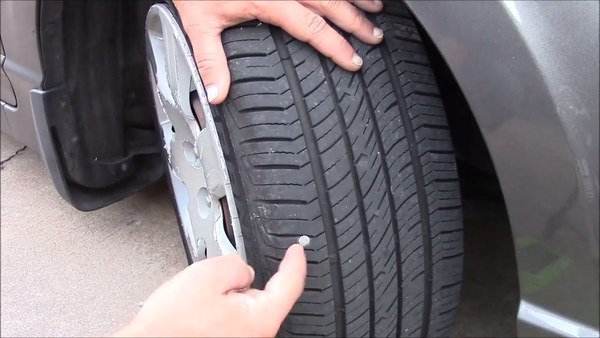A slow tire leak is more than just a nuisance. A leak can lead to low tire pressure. Not to mention, prolonged running on an underinflated tire can lead to more extensive tire damage or even cause a dangerous blowout.
If you’re experiencing a slow leak, here are some things to look for:A tire puncture: It is a common misconception that a puncture will cause the tire to immediately go flat. However, in many cases the object that caused the puncture remains lodged in the tire and prevents the air from leaking out quickly. As with all tire leaks, it is important not to ignore a puncture. Eventually the object will either wear down and/or work its way out of the tire. For more on this read our article How to Repair a Tire with a Safe, Permanent Fix.
Wheel damage: Another common cause for slow tire leaks is damage to the area where the tire bead meets the rim. This type of damage is typically cause by the driver hitting the curb, taking a speed bump at high speeds OR those dreaded potholes! The impact deforms the wheel’s metal surface which may cause the tire to pull away from the mounting surface of the wheel.
Valve stem damage: The third most common cause for slow tire leaks is worn out or damaged valve stems. Time, use and exposure to elements can cause your valve stems to wear out and cause leaks.
Diagnosing your tire leak:
If your vehicle is equipped with TPMS, you will know right away if you have a leak. If the sensor light on your dashboard goes off, you inflate all the tires back to proper pressure and the light goes back on a few days later – you likely have a leak. If your vehicle does not have TPMS, its important to check your tire pressure regularly.
Once you’ve identified that you have a leak, use TECH Chek to locate the source of your leak. Simply spray the product all around the tire. Where the surface of the tire begins to bubble is likely the source of your leak.
Where the surface of the tire begins to bubble is likely the source of your leak.
It’s important to have your tire diagnosed by a professionally trained tire shop or mobile tire repair service as soon as possible. In the case of a puncture, you may want to use a tire repair kit to keep your tire properly inflated until you can have it serviced. The leak should then be permanently fixed using a proper tire repair consisting of a cured rubber stem and repair unit.
If the leak is caused by a damaged valve, a trained tire technician can typically replace the valve at a minimal cost. In some cases, however, the tire may need replaced.
If the leak is caused by a damaged wheel, a tire technician may be able to reseat and seal the tire using a bead sealer. However, if the damage to the wheel is significant, unfortunately that means you may need to replace the wheel itself.
To read more about the types of damage that can and cannot be repaired, click here!
Your tires are where the rubber meets the road – literally – when it comes to the safety and performance of your car. That means, if your tire is leaky, you could be putting your safety at risk.
That means, if your tire is leaky, you could be putting your safety at risk.
A leaky tire causes low tire pressure, which can decrease fuel economy, and put you at risk for a blowout. It also decreases the ability of your car to handle properly, making it more difficult to respond to emergency situations or drive in inclement weather.
In this article, we’ll discuss how you can diagnose and fix slow tire leaks. Don’t just ignore that low pressure sensor – check out this guide!
The Most Common Causes Of Slow Tire LeaksThere are three common issues that cause slow tire leaks. Let’s discuss each one of them now.
If your valve stem is damaged, there will be a slow and constant leak. This leak could come from either the body of the valve, or the base of the valve, where it meets the tire.
This leak could come from either the body of the valve, or the base of the valve, where it meets the tire.
Contrary to popular belief, puncture damage usually doesn’t lead to an immediate flat tire or blowout, in most cases. This is because the object usually remains lodged in the rubber, preventing air from leaking quickly.
There are a few ways you can diagnose a slow tire leak
 If one of your tires seems perpetually under inflated, chances are you have a leak.
If one of your tires seems perpetually under inflated, chances are you have a leak.If you have a slow tire leak, you’ll want to have it repaired professionally as soon as possible. In some cases, you may want to keep a tire plug or patch kit in your vehicle. These kits are easy to use, and can keep your tire inflated until you bring it to a professional tire repair shop.
To permanently fix a tire leak caused by a puncture, you will need a “plug and patch”. This method of repair involves removing the tire from the wheel, and placing a combination plug and patch on the tire.
If your leak is caused by a faulty valve, you may need to replace it or your tire. Leaks caused by a damaged mounting surface may require you to replace the entire wheel.
Leaks caused by a damaged mounting surface may require you to replace the entire wheel.
If you need to repair a tire damaged by a puncture, or you think your valve or mounting surface may be damaged, we can help!
Schedule your appointment on Ride Time today, and come to our service centre now in Winnipeg, to make sure you stay safe on the roads!
Well thought out and functional system! I bought this TPMS a month ago and immediately installed it on my Mercedes Atego, it was easy and everything worked as intended. Before buying the INCAR system with TPS-1 sensors, I exchanged several letters with the company, and always received a prompt response.
I bought external sensors without a manifold, so I will have to remove them every time I inflate the tires. For me it does not matter much, the caps still had to be unscrewed. The issue of theft is irrelevant, so I immediately twisted the protective casings, then took silicone sealant and made a thin layer around the “seam” on each sensor so that water would not penetrate into it. Unlike other pressure sensors, these can be replaced with batteries... about every 2 years, according to the manufacturer, so you don't have to buy new sensors. It turns out that they can be opened to change the battery, and water or water vapor can seep inside, so the silicone sealant should prevent this. I also taped on labels with sensor numbers 1-6, so now I will not mix them up when reinstalling. It would be nice if the delivery included a sheet with such labels. nine0005 I then set the driver display for high and low pressure ranges (-5% under standard tire pressure and +18% for high) and temperature range (used the default). Now I think that + 18% is too little and it will be necessary to set + 20% overpressure if the tires overheat in summer and the sensor starts to work prematurely. I also measured the pressure in all six tires with a pressure gauge before installing the INCAR TPMS system, to verify the accuracy of the gauges later. nine0005 I then made sure the spools were clean and applied some WD-40 to each and proceeded to install the sensors one at a time, following the order on the TPMS display.
Unlike other pressure sensors, these can be replaced with batteries... about every 2 years, according to the manufacturer, so you don't have to buy new sensors. It turns out that they can be opened to change the battery, and water or water vapor can seep inside, so the silicone sealant should prevent this. I also taped on labels with sensor numbers 1-6, so now I will not mix them up when reinstalling. It would be nice if the delivery included a sheet with such labels. nine0005 I then set the driver display for high and low pressure ranges (-5% under standard tire pressure and +18% for high) and temperature range (used the default). Now I think that + 18% is too little and it will be necessary to set + 20% overpressure if the tires overheat in summer and the sensor starts to work prematurely. I also measured the pressure in all six tires with a pressure gauge before installing the INCAR TPMS system, to verify the accuracy of the gauges later. nine0005 I then made sure the spools were clean and applied some WD-40 to each and proceeded to install the sensors one at a time, following the order on the TPMS display. The display was kept within 10 cm of the sensor during its installation. Actually, the range of the device is 15 m, so it is not clear why I had to be near the sensors. I expected the driver display to show tire pressure and temperature, but no. First it shows the ID number of the sensor, and then the pressure and temperature appear - after everything is set around, and you hold the CODE button for 6 seconds. nine0008
The display was kept within 10 cm of the sensor during its installation. Actually, the range of the device is 15 m, so it is not clear why I had to be near the sensors. I expected the driver display to show tire pressure and temperature, but no. First it shows the ID number of the sensor, and then the pressure and temperature appear - after everything is set around, and you hold the CODE button for 6 seconds. nine0008
I mounted the display in a convenient location on the glass and started to test its operation. When I first turned on the system (it has a 60 hour internal battery or is running on a 12v power supply or RS232 which I don't need) the tire pressure didn't show up on the screen even though the system was definitely working with all tires! I was confused that I did something wrong or there was a problem, but still after a short period of time, another sensor appeared on the display. Apparently it takes 60 seconds or so to turn them all on when you turn on the device. So I went outside and twisted the sensor to simulate rapid tire loss, and immediately the display beeped and flashed. In general, as stated in the instructions, only failure reports appear quickly, under normal conditions, signals are rarely transmitted. nine0008
In general, as stated in the instructions, only failure reports appear quickly, under normal conditions, signals are rarely transmitted. nine0008
Very happy with this device. If you want to save money and not lose quality, then INCAR TPMS is the best choice.
– Ivan Nikolaev, Ural-Service Company
11/17/2018
No one is safe from such a trouble: the wheel suddenly depressurized, and the driver, a minute ago quietly sitting in a cozy cabin, faces a problem: what to do about it? nine0008
Let's start with the fact that a tire puncture on a modern car still needs to be noticed. Therefore, the driver needs to monitor the force on the steering wheel, the noise from the wheels and the tire pressure indicators on the instrument panel (if any). If a punctured wheel is not noticed in time, the tire will be completely chewed up and the issue of its repair will be removed: only a replacement.
If a punctured wheel is not noticed in time, the tire will be completely chewed up and the issue of its repair will be removed: only a replacement.
But we will proceed from the fact that the puncture was noticed in time. If there are signs of a flat tire - the car is pulling to the side, a rumble or rhythmic noise from the side of the wheel, wagging the stern - you need to gradually reduce the speed and slowly pull over to the side of the road in a safe place. Dealing with a flat tire right on the roadway is dangerous, you should not do this. nine0008
It is not always possible for the driver to solve the problem of a flat tire on his own. But you need to try to find a puncture or air leak in order to immediately decide on a strategy for solving the problem.
 nine0022
nine0022  The design of the tire is such that only a small hole in the sidewall (about 5 mm) can be eliminated in the field, and then only with a special repair sealant that is blown into the tire through a valve.
The design of the tire is such that only a small hole in the sidewall (about 5 mm) can be eliminated in the field, and then only with a special repair sealant that is blown into the tire through a valve.
 nine0022
nine0022
First of all, do not immediately remove the flat tire to repair it or change it to a spare tire. Try to determine the intensity of the air leak. It may be easier to pump up a flat tire with a compressor or pump and drive to the nearest tire shop, where professionals will take care of it. In some cases, for example, if two wheels are damaged with one available spare tire, only periodically pumping up a better preserved tire and you can get to the service station. “Promising” in this regard is a leak at the place where the tire fits on the rim and a puncture on the tread - usually such damage does not lead to an intensive release of air, that is, by pumping up the wheel, it is quite possible to get to the workshop. nine0008
If the decision is made to have the wheel repaired on site, follow these tips.
